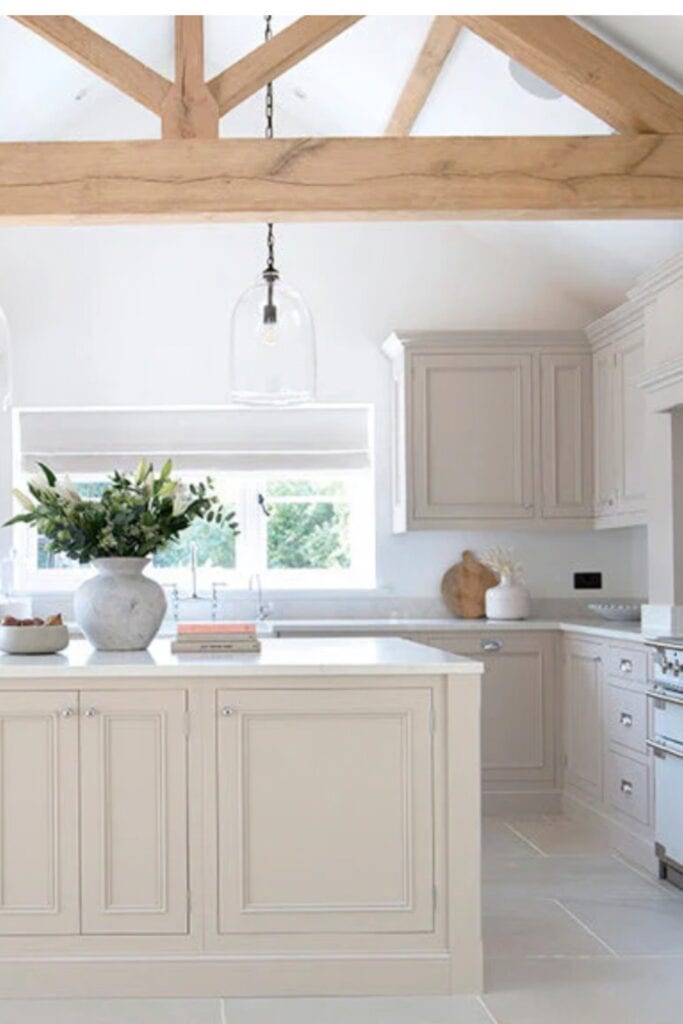7 Kitchen Flooring Ideas: Budget-Friendly to Luxury Options That Wow
If you’re like us, the kitchen is the heart of your home. With three teenagers who also enjoy cooking and baking, our family lives in the kitchen! And while countertops and cabinets usually get all the design attention, your kitchen floor works just as hard—if not harder. It handles spills, heavy foot traffic, dropped pans, and everything in between.
That’s why choosing the right surface isn’t just about looks—it’s about function, durability, and comfort. In this guide, we’re diving into kitchen flooring ideas for every budget, so you can find a solution that’s not only stylish but built to withstand real life!
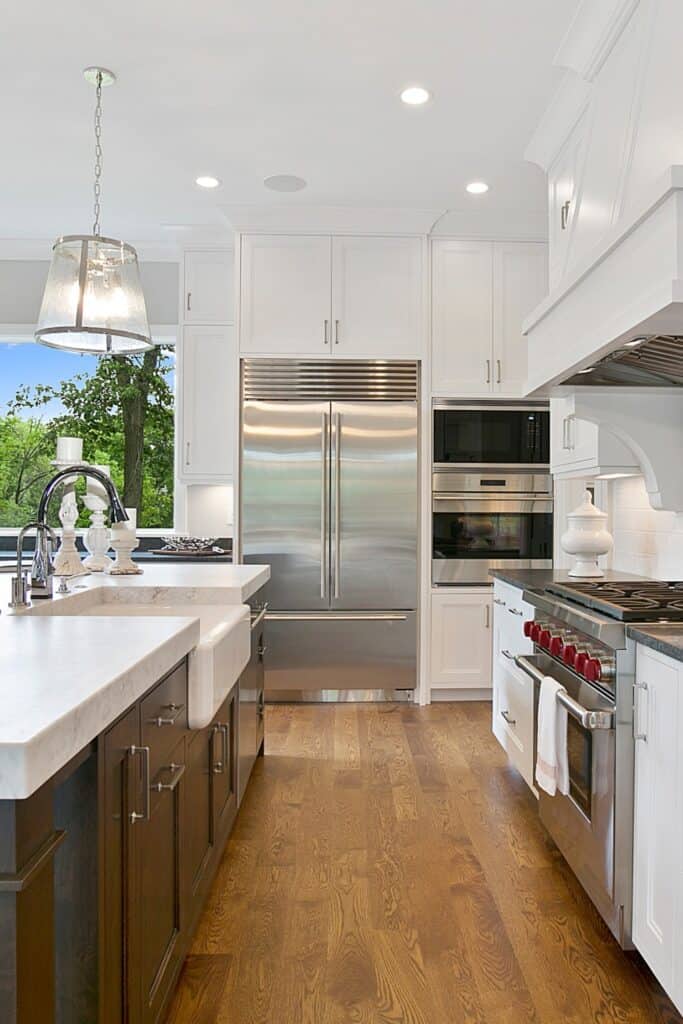
Let’s look at seven different options in order from most to least expensive:
#1 Hardwood Flooring
Contents
Hardwood flooring brings a warm, timeless charm to any kitchen space. Its natural wood grains and color variations make it visually appealing and versatile for many design styles. Hardwood floors can last for decades if properly maintained, making them a practical investment.
While they need some care to avoid water damage, their ability to be refinished adds to their longevity. Many homeowners appreciate the cozy, inviting atmosphere hardwood floors create in their kitchens.
- Durability: High-quality hardwoods like oak and maple withstand daily kitchen activities well and can be sanded down and refinished multiple times to revive their look. Their firm surface supports a busy space without cracking or warping under normal use. Proper sealing protects against minor spills, keeping the wood safe from moisture damage.
- Aesthetic Appeal: Hardwood floors offer natural warmth and character that improve with age, featuring unique grain patterns and color tones. They blend effortlessly with both rustic farmhouse and modern minimalist kitchen designs. Plus, they complement a wide range of cabinetry and countertop colors.
- Maintenance: Routine sweeping and occasional mopping with wood-safe cleaners keep hardwood floors looking fresh. Avoid excessive water to prevent swelling or warping, and use felt pads under furniture to prevent scratches. Prompt spill cleanup is essential to preserve the finish.
- Comfort: Hardwood provides a softer, more forgiving surface than tile or stone, making it easier on feet and legs during cooking and cleaning tasks. The warm feel underfoot adds an inviting touch to kitchen time. It’s also quieter, absorbing sound better than harder floors.
- Value Addition: Installing hardwood floors often boosts home resale value due to their classic appeal and longevity. Buyers typically recognize hardwood’s quality and attractiveness, considering it a premium flooring option. This makes it a smart choice for long-term investment.
Hardwood flooring offers a balanced combination of beauty, comfort, and durability that many kitchen owners desire. Although it requires some mindful maintenance, the rewards of its natural charm and lasting appeal are considerable. If you appreciate a warm, welcoming kitchen vibe, hardwood is a wonderful option to consider.
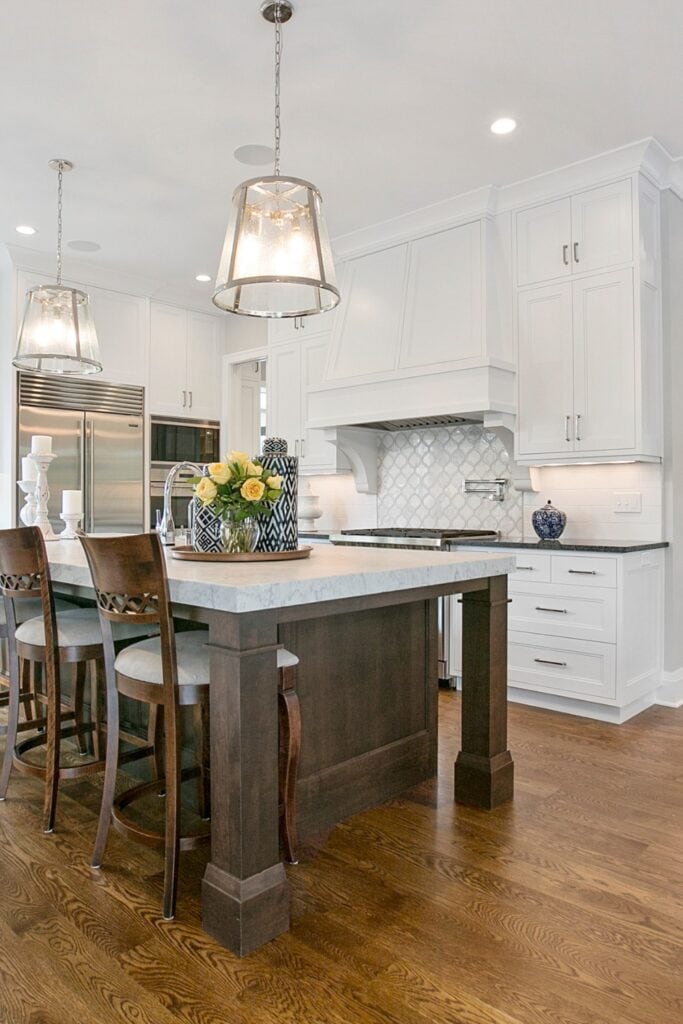
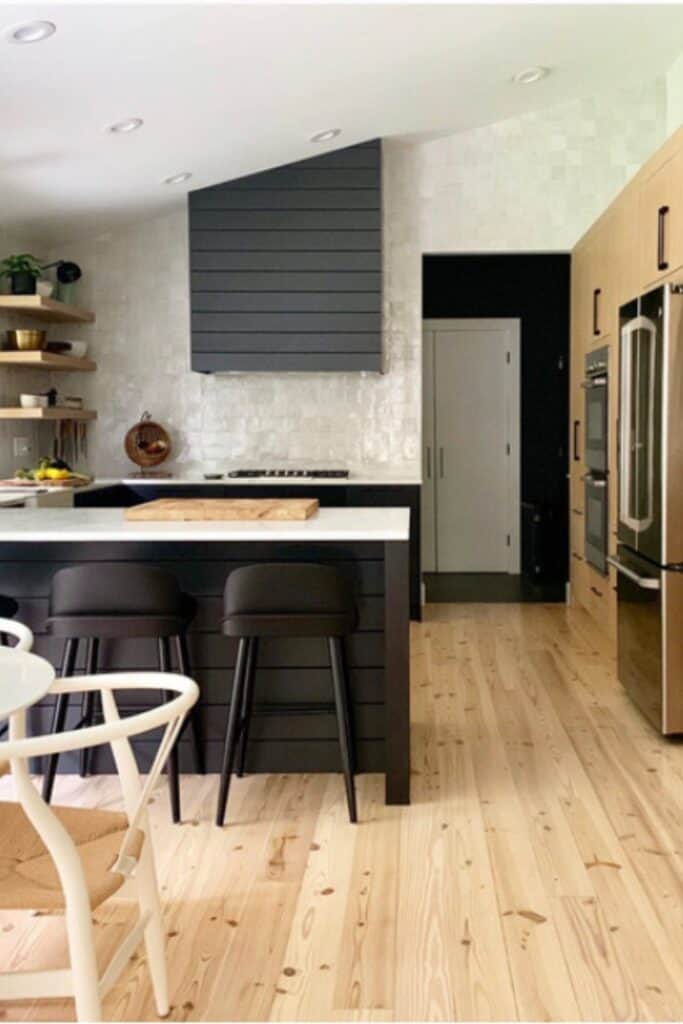
CHECK IT OUT: 10 Ways to Save on a Kitchen Remodel
#2 Natural Stone Tiles
Natural stone tiles such as slate, marble, and travertine offer a unique, luxurious appeal to any kitchen floor. The rich textures and organic patterns found in stone create a striking and timeless backdrop.
Stone is incredibly durable and long-lasting, but it does come with certain maintenance needs to keep it looking pristine. It’s a favorite among those who appreciate natural beauty paired with strong performance.
- Variety of Stones: Common stone choices include granite for durability, marble for elegance, slate for texture, and travertine for warm earthy tones. Each stone type features distinct colors, grain patterns, and finishes that make every floor truly one-of-a-kind. These options allow for customization to suit a wide range of kitchen designs.
- Durability: Natural stone is known for its ability to withstand heavy foot traffic and resist wear over time. However, some stones like marble can be more prone to scratches or etching, so selecting the right type based on kitchen use is important. Proper sealing enhances stone’s resistance to stains and moisture infiltration.
- Maintenance Requirements: Stone floors require regular sealing to protect against spills and stains due to their porous nature. Routine cleaning with stone-safe products is essential to prevent damage from acidic substances common in kitchens. Occasional polishing can revive the stone’s natural luster and maintain its luxurious look.
- Aesthetic Impact: Stone flooring offers an organic, earthy feel that adds depth and sophistication to kitchen interiors. Over time, natural weathering can enhance the visual appeal, creating a lived-in yet elegant atmosphere. It pairs beautifully with natural wood cabinets and metals for a well-rounded look.
- Cost Considerations: Natural stone tiles tend to be on the pricier side given the material and installation complexity. Professional installation is usually necessary due to the weight and cutting precision involved. Despite the initial expense, many consider it a worthwhile investment for its durability and beauty.
If you’re drawn to the idea of a kitchen floor that tells a story through texture and natural variation, stone tiles deliver magnificently. Despite requiring a bit more care, their long lifespan and stunning aesthetics reward your effort. They are especially suited for those who enjoy an enduring, personalized kitchen style.
#3 Porcelain and Ceramic Tiles
Porcelain and ceramic tiles are among the most popular choices for kitchen floors due to their versatility and resistance to moisture. They come in countless colors, patterns, and textures, allowing you to get creative with your kitchen style.
Both tile types are fairly low-maintenance, making them a wise pick for busy households. Tiling your kitchen floor also offers excellent durability, standing up well to heavy foot traffic and spills.
- Variety of Designs: Tiles are available in a wide range of sizes, shapes, and surface finishes, from glossy to matte to textured. You can even find designs that mimic the look of natural stone or wood, giving you style flexibility. Pattern combinations, such as herringbone or checkerboard, elevate the visual interest of your floor.
- Water Resistance: These tiles are inherently resistant to moisture, making them ideal for kitchens where spills and splashes happen regularly. The glazed surface on porcelain tiles adds an extra protective barrier to guard against stains. Proper grout sealing (this is key!) helps maintain their spotless appearance.
- Durability: Both ceramic and porcelain tiles are hard and resilient, able to resist scratches, dents, and wear. Porcelain tends to be denser and more durable than ceramic, making it a great choice for very high-traffic kitchens. They also stand strong against heat, so you don’t need to worry about accidental dropped pots or pans.
- Maintenance: Cleaning tiles is straightforward—regular sweeping and mopping keep them spotless without much effort. Occasional grout cleaning and resealing ensure your floor continues to look its best. Tiles don’t hold onto odors or allergens, enhancing kitchen hygiene.
- Cost Considerations: Ceramic tiles tend to be more budget-friendly, whereas porcelain can be more expensive due to its density and durability. Installation costs vary but can be higher because tiles require professional laying and grouting. However, their longevity often justifies the upfront investment.
Porcelain and ceramic tiles bring beautiful functionality to kitchens that need a stylish yet tough floor option. Their ability to handle wet conditions and variety of design choices gives you a lot of creative freedom.
If durability and ease of care are priorities for your kitchen flooring, these tiles are an excellent match.
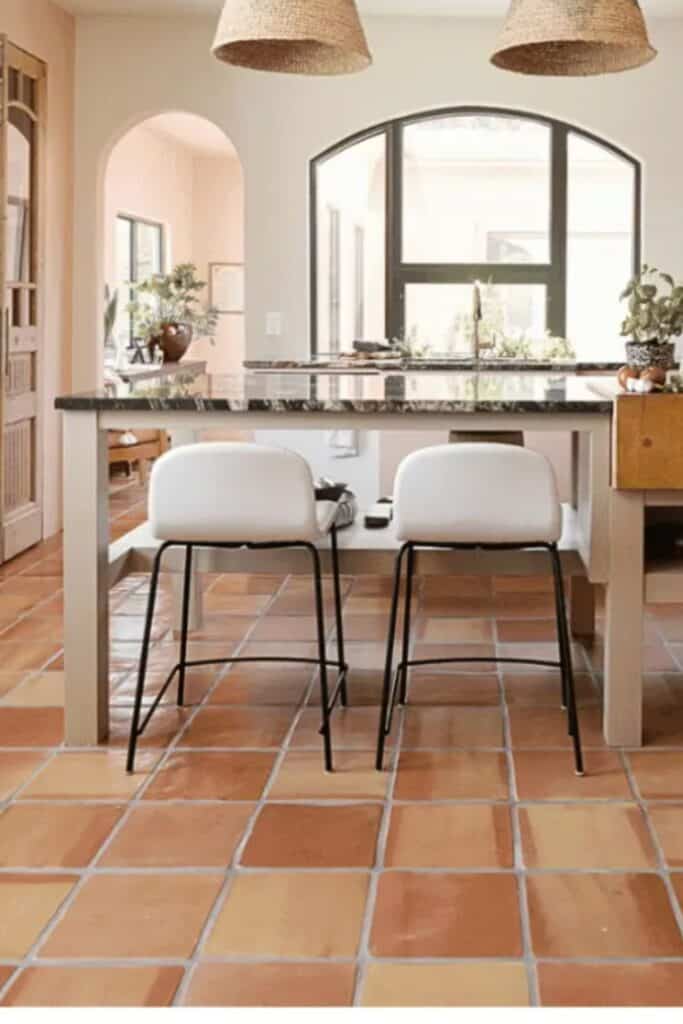
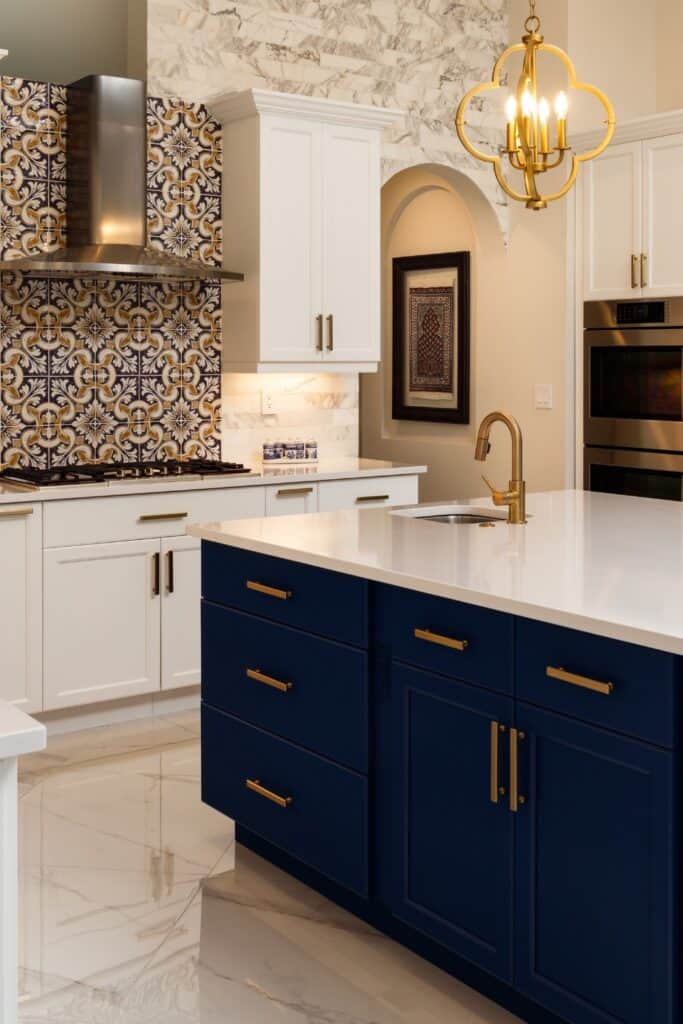
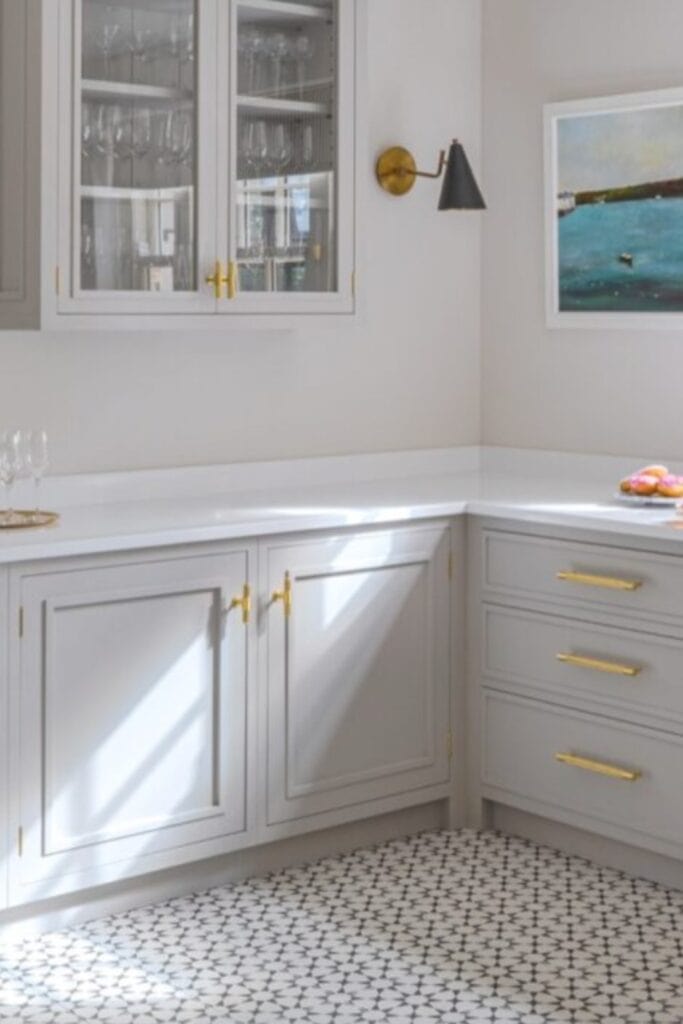
CHECK IT OUT: The Best Kitchen Cabinet Colors
#4 Luxury Vinyl Planks (LVP)
Luxury Vinyl Planks have gained popularity as a modern, budget-friendly alternative that mimics the look of hardwood or stone. They are highly water-resistant, making them a practical kitchen flooring solution, especially in homes with pets or children.
LVP offers a comfortable underfoot experience and installs easily over existing floors. When we were ready to upgrade our kitchen flooring, we chose LVP flooring and installed it over our existing linoleum. They turned out beautifully! Beyond looks, their durability and stain resistance make them a go-to for busy cooks.
- Appearance: LVP comes in a wide variety of styles that realistically replicate natural wood grains, stone textures, and other materials. With advanced printing techniques, the planks often feature textured surfaces to add a tactile feel. This allows homeowners to achieve the trendy hardwood look without the high cost or maintenance.
- Water Resistance: Made from synthetic materials, LVP is highly resistant to water, staining, and even scratches. Its waterproof qualities mean it performs well in moist kitchen environments where spills are frequent. This makes cleanup easy and prevents damage from liquid exposure.
- Installation: Many LVP products feature click-lock designs enabling quick DIY installation, which can save you money. They can often be installed over existing floors such as tile or concrete, reducing prep time. The planks’ flexibility also makes them adaptable to a variety of subfloor surfaces.
- Comfort: LVP tends to be softer and warmer underfoot than tile or stone, providing cushioning that relieves foot fatigue. Some versions even include an attached underlayment for extra sound absorption and comfort. This feature is especially appreciated during long cooking or cleaning sessions.
- Cost and Maintenance: LVP is generally more affordable than hardwood or natural stone while offering similar aesthetic benefits. Maintenance involves simple sweeping and occasional mopping with vinyl-safe cleaners. Additionally, its robust surface resists stains and dents, minimizing repair needs.
Luxury Vinyl Planks strike a pleasing balance between style, practicality, and cost, making them a favorite for updated kitchen floors. If you want the look of natural materials combined with resilience and ease,
LVP might just be the perfect flooring type for your space. This modern solution is especially convenient for households seeking straightforward upkeep.
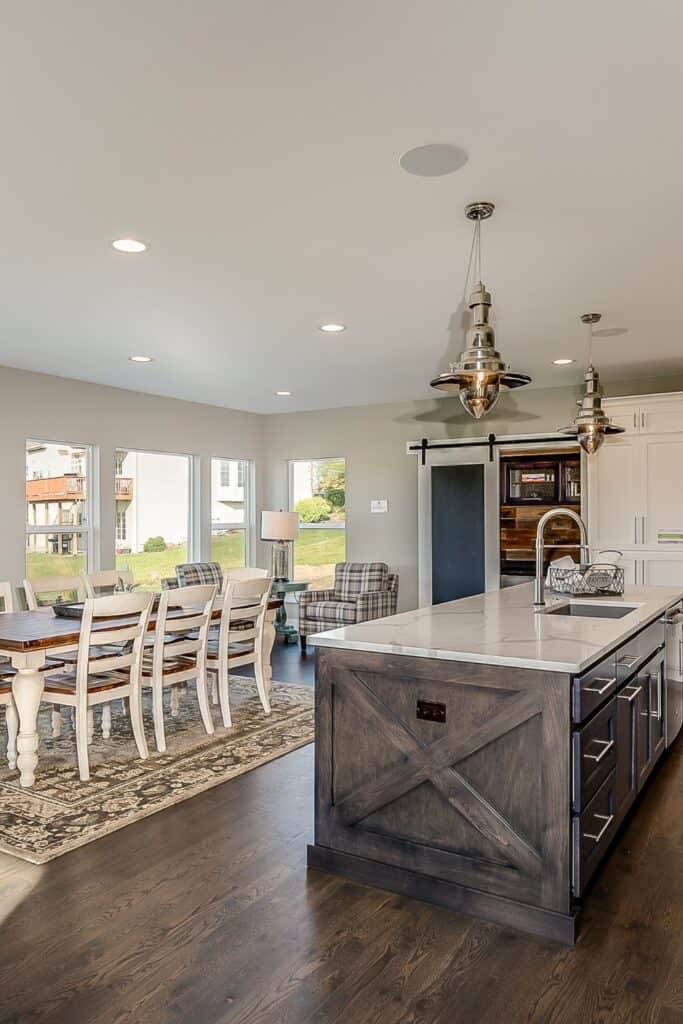
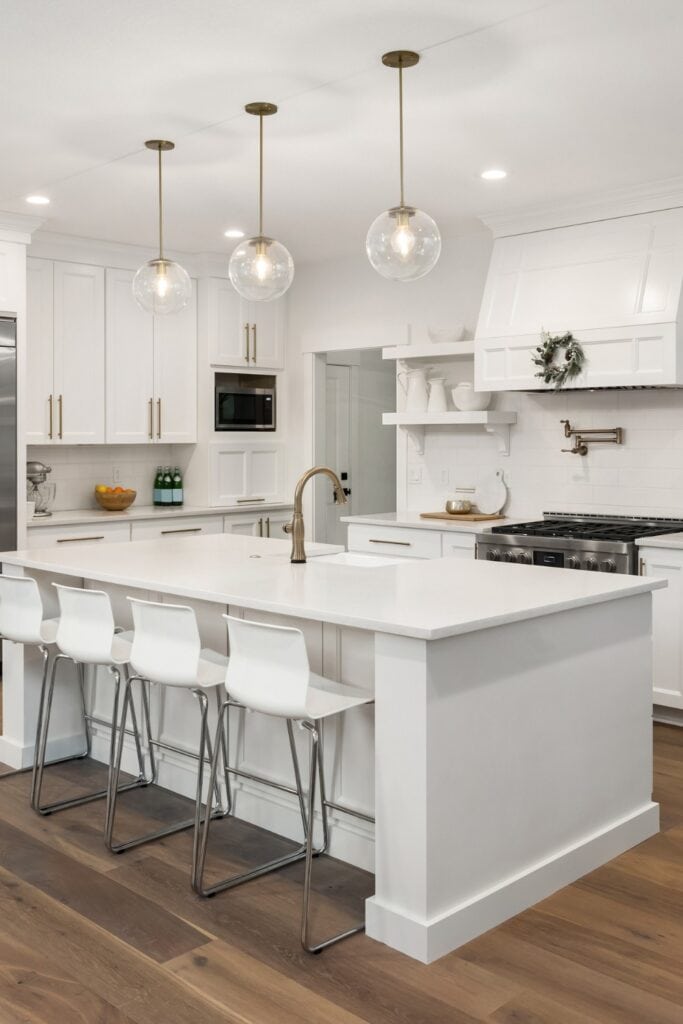
#5 Bamboo Flooring
Bamboo flooring has carved out a niche as an eco-friendly, stylish option for kitchens. It features a distinct, fine-grained look that can be light or dark depending on the bamboo type and treatment.
Bamboo is technically a grass, which regrows faster than hardwood trees, making it a sustainable choice. Its natural strength and resilience suit the demands of kitchen foot traffic well.
- Sustainability: Bamboo grows rapidly and requires less water and pesticides compared to hardwood trees, making it one of the greener flooring materials available. Harvesting bamboo doesn’t kill the plant, allowing new shoots to grow quickly. This renewability appeals to environmentally conscious homeowners seeking responsible options.
- Aesthetics: Bamboo flooring displays a clean and contemporary look with smooth, uniform grains. It fits well with modern, Asian-inspired, or eco-friendly kitchen designs. The material can be stained or carbonized to achieve various color depths, from pale beige to rich caramel tones.
- Durability: Strand-woven bamboo is especially strong, often harder than traditional hardwoods, making it resistant to dents and scratches. Its resilience to moisture is moderate but improved with proper finishes and prompt spill management. It supports busy kitchens without losing its charm quickly.
- Maintenance: Bamboo floors are relatively easy to care for with regular sweeping and damp mopping. Avoid excess water to prevent swelling or warping, and use wood-friendly cleaning solutions. Occasional refinishing can restore their sheen and extend their lifespan.
- Cost and Installation: Bamboo falls in a mid-range cost category, typically more affordable than hardwood flooring because of the shorter growth time and ease of harvesting. It can be installed as click-lock planks or glued down, depending on your preference and subfloor condition. Its installation flexibility makes it accessible for DIY or professional installation.
Bamboo flooring offers an appealing mix of natural beauty, sustainability, and strength that fits many kitchen lifestyles. It’s a fantastic choice if you want a floor that looks sleek and modern while being mindful of the environment. Its durability and ease of care add practical benefits to its green credentials.
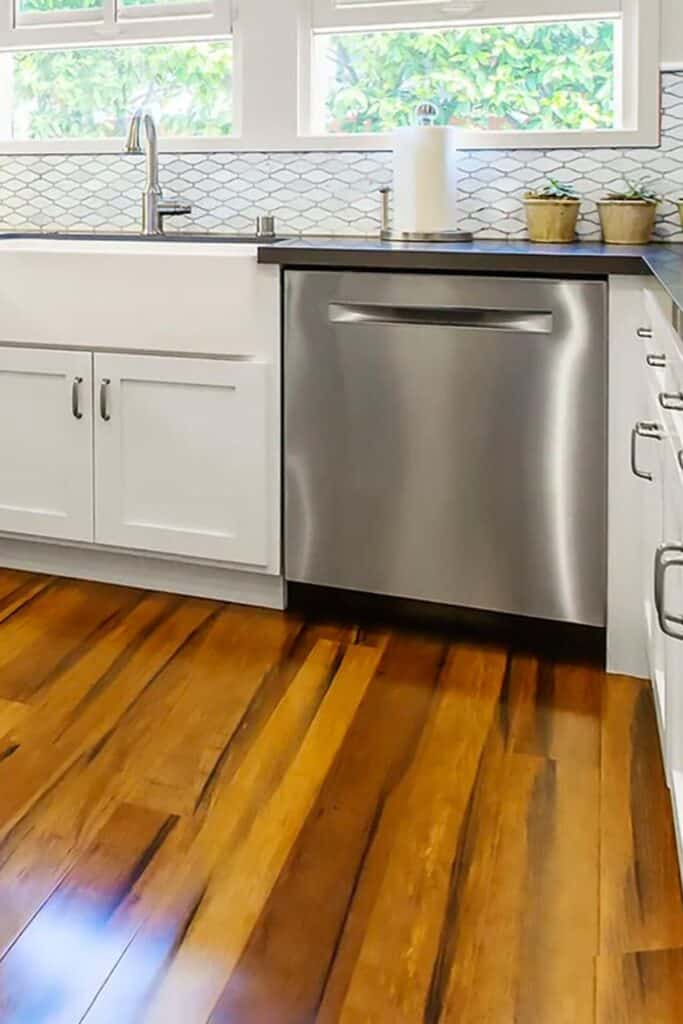
#6 Peel and Stick Vinyl Tiles
Peel and stick vinyl tile is a budget-friendly, DIY dream for homeowners looking to refresh their kitchen floors with minimal effort and maximum impact. This flooring solution has surged in popularity thanks to its ease of installation, stylish design options, and surprising durability.
It’s ideal for renters, busy families, or anyone wanting a quick upgrade without hiring a contractor. Best of all, today’s peel and stick vinyl tiles come in realistic textures that mimic wood, stone, and ceramic—making it easier than ever to get a high-end look for less.
Easy DIY Installation: One of the biggest advantages of peel and stick vinyl tile is right there in the name—no nails, grout, or glue needed. Simply remove the backing and press the tiles onto a clean, dry subfloor. It’s a weekend project even a beginner can tackle. Need to replace a damaged tile later on? Just peel it up and stick down a new one.
Style on a Budget: Modern peel and stick tiles are lightyears beyond the basic patterns of the past. Available in faux marble, concrete, slate, wood, and more, these tiles offer design flexibility that suits farmhouse kitchens, modern spaces, or classic layouts. Some versions even include textured finishes for added realism.
Durability: While peel and stick vinyl tile isn’t as long-lasting as luxury vinyl plank or traditional tile, it still holds up surprisingly well—especially in lower-traffic kitchens. Many styles are water-resistant and stain-resistant, making them a solid pick for families with kids and pets. Just avoid dragging heavy furniture or using harsh cleaners to extend their lifespan.
Maintenance: A simple sweep and an occasional mop with a gentle cleaner will keep your vinyl tiles looking fresh. Since the surface is smooth and sealed, spills wipe up quickly, making it a great option for households like ours where cooking experiments are a daily occurrence.
Installation and Cost: Peel and stick vinyl tile is one of the most affordable kitchen flooring ideas out there, both in terms of materials and installation. You’ll save even more by doing it yourself—no special tools required. Just be sure the floor underneath is clean, level, and dry for the adhesive to bond properly.
Peel and stick vinyl tile is proof that you don’t need a big budget to make a big impact. With its blend of style, simplicity, and value, it’s a go-to choice for quick kitchen upgrades that still look polished and pulled together.
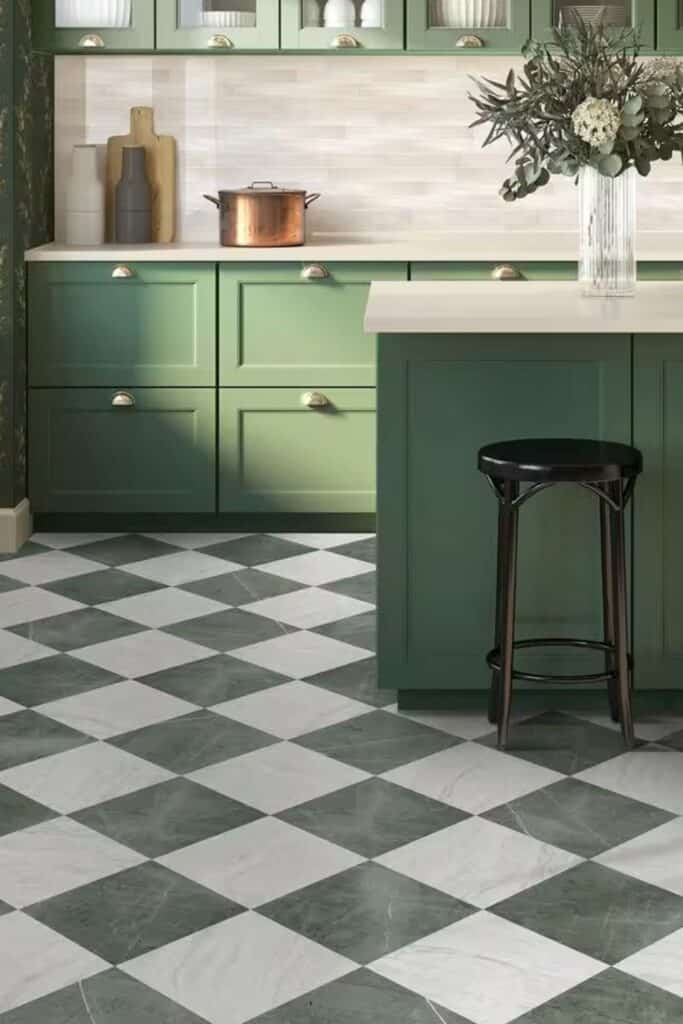
#7 Linoleum Flooring
Linoleum flooring is a classic choice making a modern comeback due to its eco-friendliness and variety of design options. It is crafted from natural materials like linseed oil, cork dust, and wood flour, offering a biodegradable alternative.
Linoleum’s smooth, matte finish and broad color selection provide a cheerful, inviting vibe for kitchens. It is resilient and surprisingly easy to maintain, making it a sensible option for different household needs.
- Eco-Friendly Composition: Linoleum is made from renewable raw materials that decompose naturally, minimizing environmental impact. It contains no synthetic plasticizers or harmful chemicals, contributing to healthier indoor air quality. This makes it an appealing option for green homes and eco-conscious buyers.
- Design Flexibility: Available in a rainbow of colors and patterns, linoleum can mimic tiles or come in bold, artistic designs. This versatility lets you create kitchens that range from playful and bright to elegantly subtle. Its seamless installation option reduces trapped dirt and grime, enhancing cleanliness.
- Durability: Linoleum is resilient and can stand up well to kitchen wear, including foot traffic and dropped utensils. It resists scratches and dents better than traditional vinyl, especially when properly maintained. Its surface also resists stains and discoloration over time.
- Maintenance: Routine sweeping and damp mopping with linoleum-appropriate cleaners keep it looking fresh without much fuss. Avoid abrasive cleaning tools or harsh chemicals that can damage the finish. Occasional polishing can restore its soft sheen and smooth texture.
- Installation and Cost: Linoleum is generally affordable and can be installed as sheets or tiles, sometimes requiring professional installation for best results. Its longevity offers good value over time. Installation over a smooth, clean subfloor ensures a flawless and durable surface.
Linoleum flooring offers an eco-conscious, versatile, and durable option that many kitchens can benefit from. Its combination of natural materials and design variety makes it a smart choice if you want to blend style with sustainability. With proper care, linoleum can provide years of cheerful kitchen support.
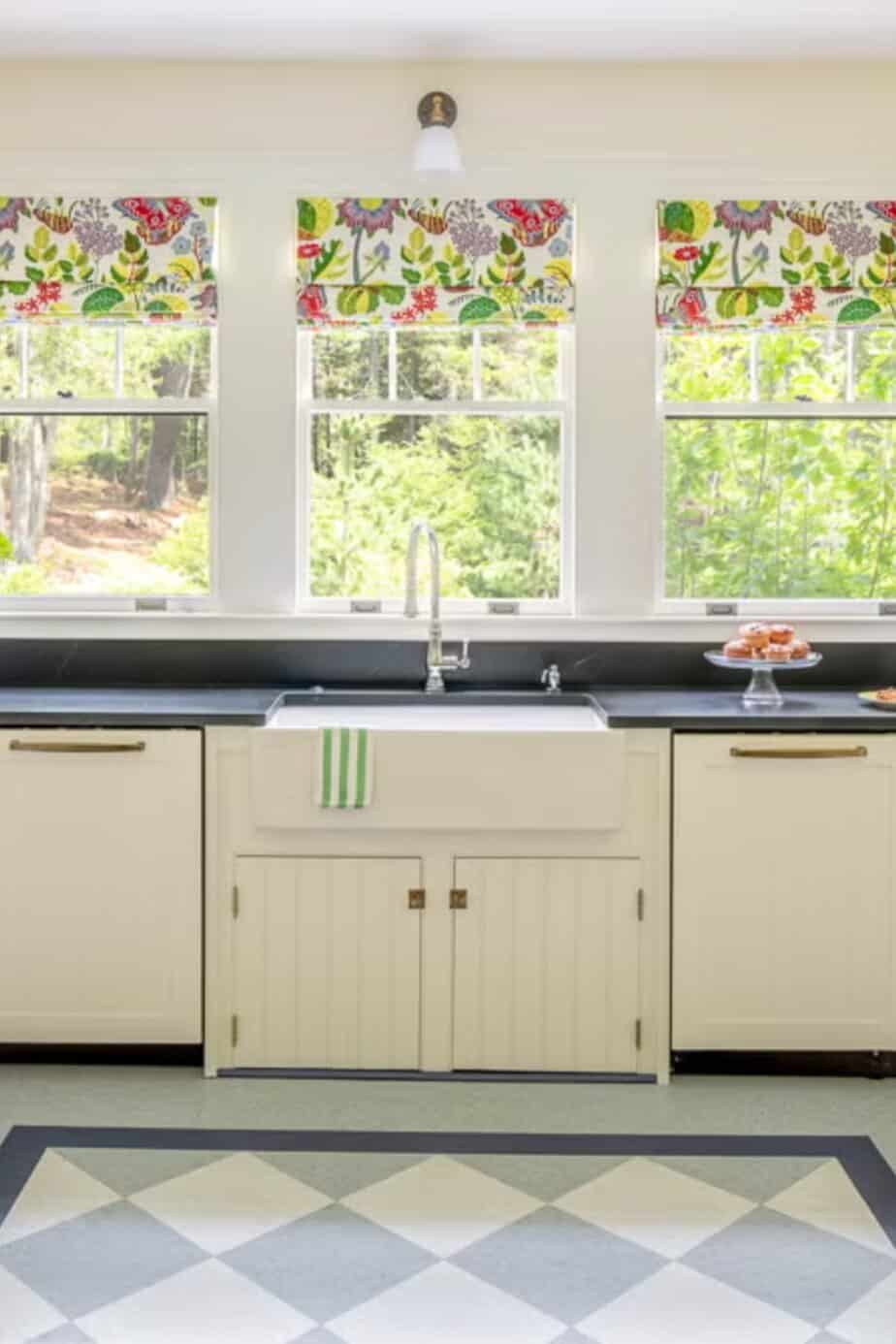
Final Thoughts: Flooring That Works as Hard as Your Kitchen Does
Your kitchen floor isn’t just a backdrop—it’s the foundation for everything from weeknight dinners to holiday baking marathons (especially when you’ve got a crew of teens helping out!).
Whether you’re drawn to the timeless beauty of hardwood, the sustainability of tile, or the budget-friendly charm of peel and stick vinyl tile, there are kitchen flooring ideas for every home, style, and lifestyle.
The key is finding a floor that not only looks great but also stands up to real life—spills, scrapes, pets, kids, and all. With the options we’ve explored, you can confidently choose a surface that suits your space and your everyday rhythm.
No matter your budget or design goals, there’s a kitchen flooring solution that can elevate your home and make your kitchen even more inviting. Because at the end of the day, the best floors are the ones you can live on—comfortably, confidently, and beautifully.

